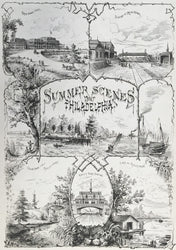Frank H. Taylor. “Summer Resorts in the Neighborhood of Philadelphia.” [Bryn Mawr, Ridley Park & Riverton, NJ].
From The Daily Graphic. New York: 1873. Wood engraving. 16 ¾ x 11 ¾ (image). Very good condition.
This print depicts summer scenes in the Philadelphia suburbs. Shown is the old Bryn Mawr Hotel (now The Baldwin School), old Bryn Mawr train station, three scenes of Ridley Park and a view of Riverton, New Jersey. Beginning around the middle of the nineteenth century, newspapers illustrated with wood engravings became hugely popular. The success of these newspapers lay in their illustrations. These prints were wide-ranging in their coverage of events, places, things and persons of interest to the readers.
Frank Hamilton Taylor a native of Rochester, New York, served briefly in the Civil War, afterwards relocating to Philadelphia, where he worked for a lithographic firm, then established his own in the 1870s. He also became a “special artist,” sketching for publications such as the Daily Graphic and Harper’s Weekly. He turned to writing articles as well as illustrating them, later publishing books on topics such as the Civil War (Philadelphia in the Civil War, 1860-1865), Valley Forge Park, the Alan Wood Steel Company, Ocean City, N. J., and the Port of Philadelphia. Aware of the importance of historical documentation, Taylor in Ever-Changing Philadelphia illustrated the status from which the city would continue to evolve.

![Taylor, Frank H. “Summer Resorts in the Neighborhood of Philadelphia” [Bryn Mawr, Ridley Park & Riverton, NJ]](http://philaprintshop.com/cdn/shop/files/philasummerscenesthmb_{width}x.jpg?v=1707937976)
![Taylor, Frank H. “Summer Resorts in the Neighborhood of Philadelphia” [Bryn Mawr, Ridley Park & Riverton, NJ]](http://philaprintshop.com/cdn/shop/files/philasummerscenes_{width}x.jpg?v=1707937975)
![Load image into Gallery viewer, Taylor, Frank H. “Summer Resorts in the Neighborhood of Philadelphia” [Bryn Mawr, Ridley Park & Riverton, NJ]](http://philaprintshop.com/cdn/shop/files/philasummerscenesthmb_110x110@2x.jpg?v=1707937976)
![Load image into Gallery viewer, Taylor, Frank H. “Summer Resorts in the Neighborhood of Philadelphia” [Bryn Mawr, Ridley Park & Riverton, NJ]](http://philaprintshop.com/cdn/shop/files/philasummerscenes_110x110@2x.jpg?v=1707937975)
